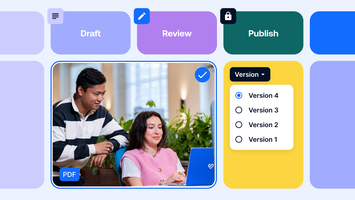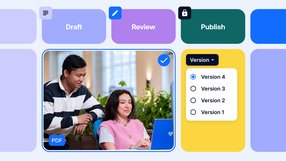In today’s hyper-competitive digital landscape, effective content creation isn't just about individual output; it's about teamwork and orchestrated efficiency. For enterprises navigating vast volumes of content and diverse stakeholder groups, traditional methods of content creation can quickly lead to bottlenecks, inconsistencies, and missed opportunities. That’s where enterprise content collaboration platforms come in, transforming the way large organizations create, review, and deliver their marketing collateral.
These indispensable tools enable teams to produce high-quality, on-brand content with speed and precision, ensuring every stakeholder is aligned from concept to publication. A robust enterprise content collaboration platform moves beyond basic file sharing, offering must-have features such as advanced version control, reliable integrations with existing digital ecosystems, AI-powered capabilities, robust permission management, and enterprise-grade security.
In this blog, we’ll explore enterprise content collaboration tools such as Bynder’s AI-powered DAM solution, delving into key features and how they can drive meaningful business outcomes for large organizations.
Key takeaways
- Enterprise content collaboration tools optimize content creation and management, ensuring brand consistency and efficiency for large organizations.
- Integrating AI features and effortless integrations with platforms like DAM, CMS, and PIM enhances content collaboration, accelerates production, and improves security.
- Bynder's AI-powered DAM is a leading solution that centralizes content, boosts productivity, and drives greater business outcomes through intelligent content management and delivery.
What are the top enterprise content collaboration tools in 2025?
1 - Bynder
Bynder’s leading, AI-powered Digital Asset Management makes content collaboration easy and accessible across teams. Its configurability ensures structure without losing flexibility, enabling quicker adoption for all users. As an enterprise system of record, Bynder’s powerful, richly integrated platform unites brand control and day-to-day usability, helping brands unlock content's full potential and accelerate business growth.
2 - AEM Assets
AEM Assets, an enterprise collaboration tool, is generally not built for modular or composable content models; its UI/UX can pose a learning curve for users, and its scalability often calls for specialized technical expertise to manage effectively. The platform's overall investment, including licensing and complex developments, can be substantial, with implementations often stretching 10 to 12 months. AEM Assets primarily integrates with other Adobe products (vendor lock-in), which could mean more effort to connect seamlessly across a broader martech stack.
3 - Aprimo
As an enterprise content solution, Aprimo is often noted for a complex implementation process that frequently requires third-party system integrators and potentially adds to costs. Getting teams fully comfortable with its UI/UX can take some effort, potentially slowing adoption, while for content delivery, the platform often relies on external third-party tools.
4 - Frontify
Frontify functions as a collaboration tool primarily recognized for its brand management capabilities. It is built around brand guidelines and offers digital asset management as a supporting solution. It's often designed with compliance-heavy industries in mind, which can lead to more rigid workflows that may not suit creative teams needing flexibility and speed. While it integrates with a range of creative and content tools, its ecosystem offers fewer options for broader marketing or commerce integrations. Its innovation in areas like AI is still evolving, meaning custom functionality sometimes requires additional development.
5 - Canto
Canto is generally better suited for smaller-scale use cases and typically doesn't meet the comprehensive demands of complex enterprise solutions. Its capabilities are often seen as more specialized, which means it typically isn't highlighted as a broad market leader by reputable analysts. While its key advantage lies in lower pricing, this often comes at the expense of comprehensive functionality, as the platform has expanded through integrating acquired solutions rather than consistent organic innovation.
Enterprise content collaboration tools FAQs
What is enterprise content collaboration software?
Enterprise content collaboration software refers to the platforms, tools, and processes that bring various parties together to produce one or more pieces of content. This includes a wide range of marketing collateral, such as blogs, case studies, video marketing campaigns, webinars, whitepapers, and brochures. It encompasses the activities and processes that allow diverse teams, and even external stakeholders like freelancers and agencies, to align their processes, workflows, and deadlines to safeguard the quality and consistency of their output. By setting up efficient content collaboration processes, brands maintain control over their brand identity and messaging across the numerous channels they use to target various audiences. Bynder’s industry-leading, AI-powered DAM helps organizations conquer the complexity and chaos of proliferating content, providing the most powerful, intuitive, and richly integrated platform for seamless content collaboration.
How do AI features enhance content collaboration?
AI features significantly enhance content collaboration by automating various aspects of the content creation process. The integration of AI within modern digital ecosystems can play a crucial role. For instance, AI contributes to accelerating content production, improving accuracy, and optimizing workflows by assisting with tasks like content generation, translation, or intelligent content suggestions. This leads to more high-quality content being brought to market more quickly, ultimately boosting overall productivity and efficiency for enterprises. Bynder’s AI-powered solutions offer cutting-edge, practical, and responsible AI technology that empowers teams to create, manage, and discover content faster and more efficiently. Solutions like Bynder’s Content Operations leverage AI-enhanced content creation and automated workflows to scale content production, ensuring only approved, on-brand content reaches the market.
What security measures should enterprises look for?
When considering enterprise content collaboration tools, robust security measures are paramount. For enterprises, securing sensitive brand information is critical. Systems that allow content creators to collaborate remotely or asynchronously must have strong safeguards in place. Enterprises should look for features that ensure controlled access, data encryption, and compliance with relevant security standards to protect their valuable marketing assets and maintain brand integrity. Bynder’s enterprise-grade DAM platform is built on a scalable SaaS infrastructure, offering comprehensive capabilities and flexible configurability to safeguard high-value assets and ensure secure collaboration for even the most demanding digital asset management needs.
How do pricing models typically work?
The pricing models for enterprise content collaboration tools typically depend on various factors related to a business's specific requirements. The choice of content creation and collaboration platforms often hinges on workflows, budget, the number of users, and available resources. Companies that need to produce high volumes of content at scale might opt for solutions with pricing models tailored to extensive usage or powerful content templating tools. Bynder’s composable and highly integrated DAM platform is designed to be as simple or as complex as needed, aligning with diverse enterprise requirements and budgets.
Which integrations matter most for large organizations?
For large organizations, integrations with existing digital ecosystems are crucial for effective content collaboration. Brands rely on the best tools and platforms that allow content creators to collaborate remotely or asynchronously within highly interconnected digital ecosystems. This implies that integrations with other essential business systems are vital. For enterprises, integrations with Digital Asset Management (DAM) systems, Content Management Software (CMS), and Product Information Management (PIM) systems are considered among the best platforms for effective content collaboration. Bynder’s composable platform integrates into any martech stack, offering powerful APIs and over 130 pre-built integrations to enhance operations and accelerate time to market. This enables enterprises to connect Bynder to their other marketing technology tools, automating workflows and delivering content experiences at scale.
Maximize impact with enterprise content collaboration
Effective content collaboration transforms fragmented content production into synchronized content performance, driving more relevant, engaging, and high-converting campaigns. For large organizations, the right content collaboration platforms are crucial for optimizing workflows and ensuring brand consistency. Bynder’s industry-leading, AI-powered DAM helps enterprises produce high volumes of content at scale, supporting efficient content collaboration processes and a strong brand identity across all channels.
Bynder’s DAM platform serves as your system of record for all digital assets, empowering your marketing ecosystem for maximum content value and 100% brand consistency. Leveraging Bynder’s AI-powered solutions for content creation, management, and discovery, enterprises can unlock content’s full potential, boost team productivity, eliminate waste, and establish consistent brand positioning.
Ready to accelerate business growth? Book a demo today to see how Bynder’s AI-powered DAM can elevate your collaborative content management, deliver impactful marketing results, and enhance team efficiency.

















